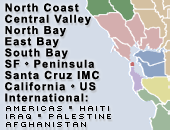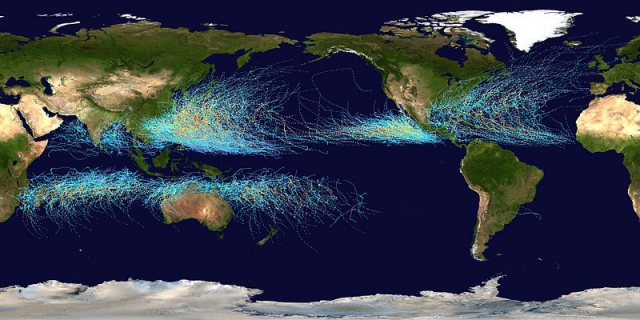Climate change predicted to escalate Tropical Cyclone damage costs for US and China
The study - The impact of climate change on global tropical cyclone damage - is by Robert Mendelsohn, Kerry Emanuel, Shun Chonabayashi & Laura Bakkensen from Yale and MIT and was published in Nature Climate Change on January 15, 2012.
Increased Tropical Cyclone damages will particularly hit the United States and China, costing $25 billion and $15 billion respectively of the additional damages from climate change. This amounts to 75 percent of the global damages caused by climate change. Small island states and especially Caribbean islands will also be hit hard, suffering the highest damages per unit of GDP.
While the overall numbers of cyclones or hurricanes are forecast to remain stable or perhaps decrease slightly, the research reveals that the ratio of weak and intense storms will change with stronger storms becoming more frequent with climate change. It is the more intense storms - Category 3, 4 , or 5, that do the most damage. Almost 93 percent of tropical cyclone damage is caused by only 10 percent of the storms.
Global warming will increase the frequency of these high-intensity storms particularly in the North Pacific and North Atlantic Ocean basins, causing most of the increase in damage. Australian CSIRO scientists have also shown a trend for Cyclone frequency declining while intensity increasing across Australia.
In the Mendelsohn study the tropical cyclone model suggested a reduction of storm power in the Indian Ocean which would reduce fatalities in Myanmar and Bangladesh, depending upon the climate model. However, a recent study of cyclones in the North Indian Ocean showed a propensity for stronger storms, that Cyclone Intensity in North Indian Ocean linked to increasing air pollution over the Indian sub-continent.
The Mendelsohn study used a tropical cyclone integrated assessment model that was developed with Kerry Emanuel, a professor of atmospheric science at MIT. "The paper demonstrates how to integrate the atmospheric science of tropical cyclones and economics," said Emanuel. The tropical cyclone model was used in conjunction with climate models to predict how the frequency, intensity and location of tropical cyclones change in the seven ocean basins of the world. The paths of 17,000 synthetic storms were followed until they strike land. The authors used historical data to estimate the damages caused by the intensity of each cyclone and what was in harm's way. According to the study minimum barometric pressure predicts damages more accurately than maximum wind speed.
The global study looked at damage costs at a national level, so that landfalls anywhere in a country are assumed to have identical impacts. Fatalities are excluded from the study due to almost 80% of global fatalities from tropical cyclones being currently concentrated in just two countries: Myanmar and Bangladesh.
Europe and South America have relatively few storms and the damage cost will likely be less than $1 billion a year. The damage cost in Africa will be low according to Mendelsohn as there is "relatively little in harm's way."
Damages costs are expected to spiral upwards for Asia and Central America due to high economic growth. The Caribbean-Central America region will have the highest damage per unit of gross domestic product of 37 percent. "When you calculate damages as a fraction of GDP, island nations are hit disproportionately hard," Mendelsohn said.
The Philippines is subject to a high number of tropical cyclones, locally known as typhoons. In October the Philippines experienced two consecutive typhoons which killed at least 76 people and caused at least US$200 million in damage to infrastructure and agriculture.
Heavy rainfall events can also be disastrous
But even heavy rain events not associated with cyclones can be extreme weather events that can cause major disasters such as the December 2011 torrential rain and Flash flooding that killed over 1000, displacing 100,000 in the Philippines. Or the extreme shift in rainfall in China in June 2011 that caused major flooding and was attributed to the effects of global warming and climate change.
Currently Fiji is experiencing heavy rain and major flooding with a 15-day state of emergency being declared in Fiji’s west coast areas. At least 8 people have died so far in the Fiji January-February 2012 floods with up to 51 reported cases of water-related diseases and $30 million in damages. A 2009 publication produced by UNISDR and the UN Development Programme (UNDP) warned that in western Fiji, high-intensity floods would become more frequent. In the Nadi area, for example, these type of floods used to occur every 190 years, but with the influence of climate change by 2100 it is projected that they will occur every 25 years.
Sources
- Yale University, February 1st, 2012 - Tropical Cyclones to Cause Greater Damage
- Robert Mendelsohn, Kerry Emanuel, Shun Chonabayashi & Laura Bakkensen, Nature Climate Change, 15 January 2012 (abstract) doi:10.1038/nclimate1357
- Image from Wikipedia - Global tropical cyclone tracks - map shows the tracks of all Tropical cyclones which formed worldwide from 1985 to 2005. The points show the locations of the storms at six-hourly intervals and use the color scheme shown to the right from the Saffir-Simpson Hurricane Scale.
Get Involved
If you'd like to help with maintaining or developing the website, contact us.
Publish
Publish your stories and upcoming events on Indybay.



